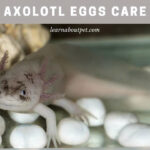You have no idea how lucky you are to have a rare baby mama! Aside from leaving axolotl eggs to hatch and expecting new roommates, do you know how to tell if axolotl eggs are alive or dead? Yes! Mama Axolotl is asking you to bring a whole plate of crickets, she has done her job. Since this is one of the most frequently asked questions: how to tell if Axolotl eggs are fertile or dead, here is a straightforward answer for you.
How to tell if axolotl eggs are dead or alive? Live eggs are either black or white while dead eggs look milky and cloudy, have swelling, odd shape, and color. To protect your egg, use dechlorinated water with proper aeration, place the tank away from direct sunlight, and regularly change your water and tanks.
For the rest of the article, we have included a special guide for both new and old Axolotl owners to help them reliably hatch their pets.
Can Axolotls Lay Unfertilized Eggs?
No. A female axolotl lays fertilized eggs unless she is late to pick up spermatophores.
It is possible to lay a few unfertilized eggs when you keep male and female separate but is unusual.
Can Axolotl Eggs Be Dead On Arrival?
It’s possible when the axolotl is not mature enough, or less than 18 months.
If you don’t know how to tell if axolotl eggs are dead, we have provided the information in our next slide.
How do I know If My Axolotl Egg Is Dead?
Not all eggs are fertilized successfully, so you may need to separate dead and live eggs. Look at the axolotl eggs dead or alive table below.
| Live Axolotl Eggs | Dead Axolotl Eggs |
| Black or white with an observable newly around them. | Milky and cloudy |
| 0.8 – 0.9 mm in size if fertilized | Swollen, cloudy substance around the eggs |
How to tell if axolotl eggs are dead. We have included three sure symptoms of dead eggs.
Milky and Cloudy
If you notice some eggs that are far from black or white, separate them to another tank. Kill the eggs before disposing of them or leave them for your Axolotl to eat.
Whilst removing the eggs, your hands should be free from any smell. Make sure not to touch the eggs with soap or hot water to avoid reducing the oxygen levels as well as aeration.
Miscreation
Any air bubbles around the egg pack mean the eggs might be dead. Bubbles are caused by the dissolution of egg yolks in the water.
Color, Shape, and Swelling
We’ve already determined the color of live axolotl eggs as either black or white. Some unusual colors might result due to the genetic makeup of the melanoid axolotl.
Look at the color, shape, and visible swelling if you’re curious if my eggs are still alive.
How Many Axolotl Eggs Will Survive?
For axolotls, eggs will only survive if bred in the right conditions. Not all eggs will survive, even if you breed them yourself. Unfortunately, the survival rate is too low, out of the 1500 eggs that are laid by an axolotl.
We have just covered how to tell if axolotl eggs are dead, let’s find out more about their survival. Six most common reasons for their death.
- Some eggs that incubate are likely to have birth defects.
- Sometimes, babies can vanish rapidly as you feed brine shrimps. Remember, the brine shrimps ought to be alive, baby axolotls do not eat anything that is dead or doesn’t move.
- You might suck up a child while changing or cleaning the water.
- Bigger axolotls will eat little axolotls that can fit in their mouths. You have to separate them by size early if you don’t want to see small axolotl babies dying.
- A number will have insufficient food and inadequate air, leading to their death.
- Some daredevil babies will jump out of the tank if the water level is close to the top of your tank.
To avoid frustrations as a beginner, only rear a few larvae at first. This helps you to focus your effort and attend to the larvae better than what might happen if you rear too many of them and struggle with insufficient resources.
You’ll also take time to learn more and avoid all these problems that most beginners face. You can get more axolotl eggs day by day step information from our Axolotl care guide.
How Do You Keep Axolotl Eggs Alive?
Even though the survival rate is low, there are required efforts to maintain survival. Two main precautions should always be observed.
- Move and change the water daily and observe water temperatures of about 18 – 20°C. The tanks that contain axolotl eggs should be kept in cool environments and away from direct sunlight. Make sure the eggs are properly spread out in the tank and there is enough air aeration.
- If you need to hatch them, you can place the eggs in warmer waters of temperatures up to 25°C, (only about a week before they hatch). These temperatures, 18 – 20°C, can keep the eggs alive for about 20 or more days.
Can You Move Axolotl Eggs So They Don’t Die?
Yes. It is easy to move axolotl eggs from one tank to another. To safely remove them, slice the outer cover or jelly that holds on the rock or leaves with your fingernails. Practice caution not to interfere with the jelly coating, and if possible use a net or a turkey master.
Always sort the embryos when they are about a day old (at room temperature they will have reached blastula stage) to remove dead or infertile and nonviable eggs from fertile eggs.
Symptoms Of Dead Axolotl Eggs
Dead eggs are milky/grey and cloudy. Looking for bacteria growth isn’t necessarily how to tell if axolotl eggs are dead. You should move dead eggs away from healthy eggs.
How To Prevent Axolotl Eggs Dying?
If you ship your eggs, they have a high chance of arriving dead because of the shake-off while in transit. To prevent axolotl eggs from dying, you have to put in maximum care to save the maximum number. Here is a way to recover or prevent most from dying.
- Place your eggs in shallow, clean, cool, and calm water and you can fit it with a thermometer to make sure you maintain the right temperature, (25°C) or 75° Fahrenheit, all the time
- If you want to hatch keep the eggs in temperatures slightly above 25°C
- Water should neither be soft nor chlorinated
If you find your axolotl hatchlings dead, it could be due to an infection or just naturally. Change their water daily as you move them to clean containers.
FAQ
Are All Axolotl Eggs Black?
Not all live axolotl eggs are black. They are either black or white depending on the genes of the mother axolotl. White, copper, and golden albino axolotls lay white eggs while melanoma axolotls lay black eggs.
How To Identify If The Axolotl Egg Is Dead Or Alive?
If the axolotl eggs are neither black nor white, it is either they are laid by a distinct axolotl or probably dead. This is the easiest way how to tell if axolotl eggs are dead.
Final Verdict On How To Tell If Axolotl Eggs Are Dead
So, what’s the best way how to tell if axolotl eggs are dead? You can easily identify dead eggs by looking at the color, shape, and swelling. You may want to look at some Haploidy and Triploidy induction research papers too to understand it better.
Live eggs are either black or white. If they look different, don’t wait for them to decay, remove them immediately or feed them to your axolotls. You have to separate adults and eggs because they can eat them.

Welcome to Learn About Pet. My name is Rajkumar Ravichandran and I love all pets, travel, and amazing food. I write about my passion and personal experience caring for multiple pets in this blog! ❤️
Post Disclaimer
DISCLAIMER: THIS BLOG OR WEBSITE, "Learn About Pet", DOES NOT PROVIDE YOU WITH MEDICAL ADVICE AND IS NOT A SUBSTITUTE FOR MEDICAL ADVICE. ALWAYS GET IN TOUCH WITH YOUR PERSONAL VETERINARIAN AND USE INFORMATION HERE AS GENERAL ADVICE.
The information, including but not limited to, text, graphics, images and other material contained on this website are for informational purposes only. No material on this site is intended to be a substitute for professional veterinary advice, food recommendation, diagnosis, or treatment. Always seek the advice of your veterinarian or other qualified health care provider with any questions you may have regarding a medical condition or for pet food related questions.







